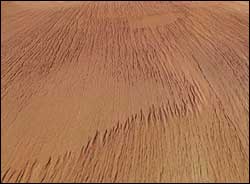’Yardangs’ On Mars

’Yardangs’ on the surface of Mars
These images of ‘yardangs’, features sculpted by wind-blown sand seen here near Olympus Mons on Mars, were obtained by the High Resolution Stereo Camera (HRSC) on board the ESA Mars Express spacecraft.
This image was taken during orbit 143 with a resolution of 20 metres per pixel. This scene shows a structure south of Olympus Mons at 6° N latitude and 220° E longitude, which was probably formed by the action of the wind. Loose sand fragments were transported by wind, and impacted on the bedrock, slowly removing parts of the surface, like a sand-blaster. If the winds blow in the same direction for a long enough period, ‘wind-lanes’, as shown in the picture, can occur. On Earth, the remnants of these features which have not been eroded away are called ‘yardangs’.
Where the surface consists of more resistant material, the force of the wind may not be strong enough to cause this sand-blasting. This might be the reason for the three flat regions (the first in the foreground on the left, and the others top right), which measure about 17 by 9 kilometres.
Media Contact
More Information:
http://www.esa.intAll latest news from the category: Earth Sciences
Earth Sciences (also referred to as Geosciences), which deals with basic issues surrounding our planet, plays a vital role in the area of energy and raw materials supply.
Earth Sciences comprises subjects such as geology, geography, geological informatics, paleontology, mineralogy, petrography, crystallography, geophysics, geodesy, glaciology, cartography, photogrammetry, meteorology and seismology, early-warning systems, earthquake research and polar research.
Newest articles

Sea slugs inspire highly stretchable biomedical sensor
USC Viterbi School of Engineering researcher Hangbo Zhao presents findings on highly stretchable and customizable microneedles for application in fields including neuroscience, tissue engineering, and wearable bioelectronics. The revolution in…

Twisting and binding matter waves with photons in a cavity
Precisely measuring the energy states of individual atoms has been a historical challenge for physicists due to atomic recoil. When an atom interacts with a photon, the atom “recoils” in…

Nanotubes, nanoparticles, and antibodies detect tiny amounts of fentanyl
New sensor is six orders of magnitude more sensitive than the next best thing. A research team at Pitt led by Alexander Star, a chemistry professor in the Kenneth P. Dietrich…





















